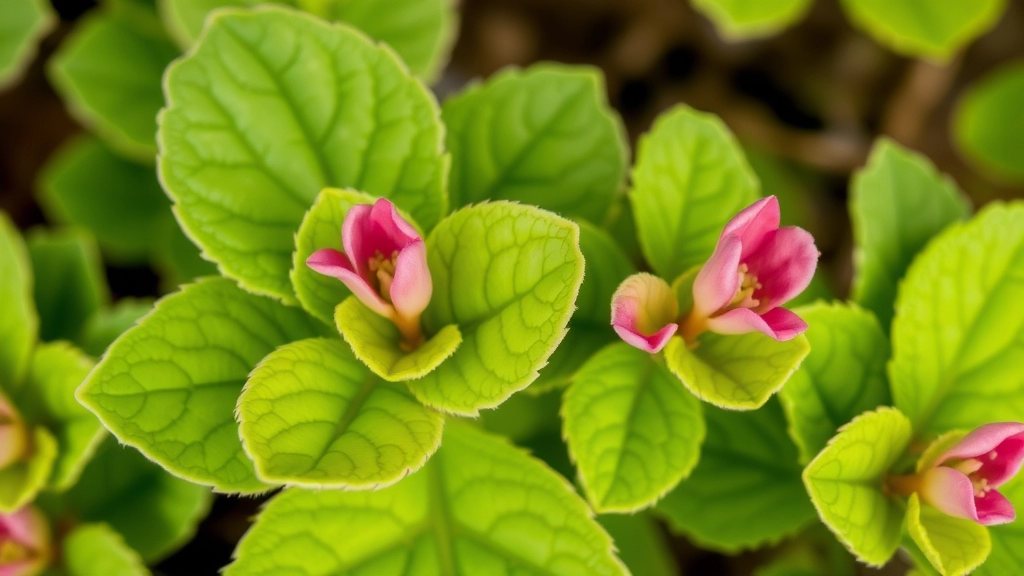Dive into the fascinating world of Kalanchoe blossfeldiana leaves with me!
As a long-time enthusiast of these vibrant succulents, I’m thrilled to share my insights on what makes these little green wonders so special. From their thick, fleshy texture to their scalloped edges and waxy coating, Kalanchoe leaves are nature’s own work of art. In this comprehensive guide, we’ll explore everything from leaf characteristics and common issues to proper care techniques and propagation methods. Whether you’re a seasoned plant parent or a curious newcomer, get ready to uncover the secrets behind keeping your Kalanchoe’s leaves lush, healthy, and bursting with color.
Leaf Care and Common Issues
Throughout this article, we’ll delve into the nitty-gritty of Kalanchoe blossfeldiana leaf care, tackling common problems like yellowing leaves and pest infestations. You’ll learn how to read your plant’s signals, adjust your care routine with the seasons, and even propagate new plants from a single leaf. So, grab your gardening gloves and let’s embark on this green journey together – your Kalanchoe’s leaves are about to become the envy of every plant lover you know!
Characteristics of Kalanchoe Blossfeldiana Leaves
Ever wondered what makes Kalanchoe Blossfeldiana leaves so special?
Let’s dive in and explore these unique little green wonders.
First off, these leaves are thick and fleshy.
They’re like nature’s water bottles, storing moisture for the plant.
The edges? They’re scalloped, giving the leaves a cool, wavy look.
Most of the time, you’ll see them in a deep green shade.
But here’s the kicker – some varieties can surprise you with red or purple tints.
The leaves grow in pairs, opposite each other on the stem.
They’re oval-shaped and can grow up to 4 inches long.
Here’s a fun fact: the leaves are slightly waxy to the touch.
This waxy coating helps the plant retain water in dry conditions.
Ever noticed how the leaves seem to shine? That’s the wax at work.
The leaves are arranged in a way that maximizes sunlight exposure.
It’s like they’re little solar panels, soaking up all that energy.
Some people say the leaves look like they’re made of rubber.
But trust me, they’re 100% natural and alive.
The leaves stay green all year round, which is pretty cool for indoor plants.
They’re tough cookies too, able to withstand some neglect (but don’t push it).
So, next time you see a Kalanchoe, take a closer look at those leaves.
They’re pretty amazing when you get to know them.
Common Issues with Kalanchoe Blossfeldiana Leaves
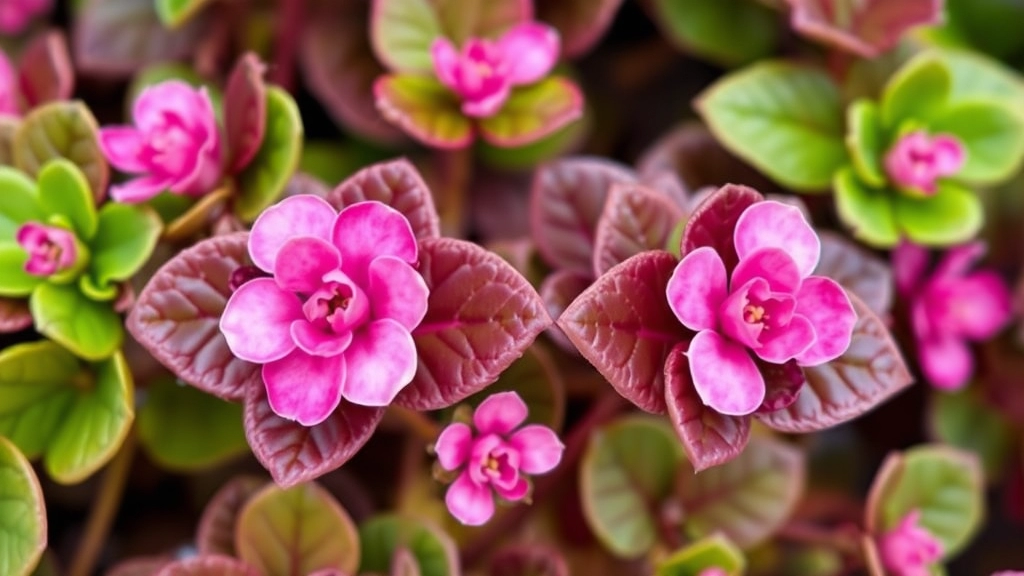
Let’s dive into the nitty-gritty of Kalanchoe Blossfeldiana leaf problems. Trust me, I’ve seen my fair share of these issues, and I’m here to spill the tea on what’s really going on with those pesky leaves.
Yellowing Leaves: The Silent Scream
Ever noticed your Kalanchoe’s leaves turning yellow? It’s like they’re waving a little yellow flag, saying, “Hey, something’s not right here!” Usually, this is your plant’s way of telling you it’s getting too much water. I once drowned my poor Kalanchoe thinking more water equals more love. Spoiler alert: it doesn’t.
Leaf Drop: The Great Escape
If your Kalanchoe’s leaves are pulling a Houdini and disappearing, you might be dealing with:
- Overwatering (again, been there, done that)
- Underwatering (yep, the opposite can be just as bad)
- Temperature stress (these guys are picky about their climate)
Brown Spots: The Unwelcome Tattoos
Brown spots on leaves are like bad tattoos – nobody wants them. They could be signs of:
- Sunburn (too much direct sunlight)
- Fungal infection (usually from overwatering or high humidity)
- Pest damage (those tiny buggers can be sneaky)
Curling Leaves: The Yoga Enthusiasts
When leaves start curling, it’s not because they’re trying out new yoga poses. This could mean:
- Underwatering (the plant’s trying to conserve water)
- Pest infestation (check for tiny invaders)
- Temperature extremes (too hot or too cold)
Stunted Growth: The Lazy Leaves
If your Kalanchoe’s leaves look like they’ve given up on life, it might be due to:
- Poor soil conditions
- Lack of nutrients
- Not enough light
Remember, Kalanchoe Blossfeldiana leaves are like mood rings for your plant. They’ll show you what’s wrong if you know how to read the signs. Keep an eye out for these common issues, and you’ll be well on your way to becoming a Kalanchoe whisperer.
Proper Care for Kalanchoe Blossfeldiana Leaves
Ever wondered how to keep those Kalanchoe leaves looking fresh? Let’s dive in.
Light
- These succulents love bright, indirect sunlight.
- Too much direct sun? You’ll see scorched leaves.
- Not enough light? Say goodbye to those vibrant colors.
Watering
- Water wisely, folks.
- Kalanchoes are drought-tolerant, so less is more.
- Wait until the soil’s dry before giving them a drink.
- Overwatering? That’s a one-way ticket to root rot.
Temperature and Humidity
- These plants thrive in average room temps.
- Avoid cold drafts and sudden temperature changes.
- Humidity? Not a big deal for Kalanchoes.
- They’re cool with normal indoor humidity levels.
Feeding
- Use a balanced, water-soluble fertilizer.
- Feed every 2-3 weeks during the growing season.
- Cut back on fertilizer in winter.
Soil and Repotting
- Soil’s gotta be well-draining.
- Mix regular potting soil with some perlite or sand.
- This prevents water from hanging around too long.
- Repot every couple of years to keep things fresh.
Pest Control
- Keep an eye out for pests like mealybugs or spider mites.
- Catch ’em early, treat ’em quick.
Proper care for Kalanchoe Blossfeldiana leaves isn’t rocket science. Give ’em the right light, water, and soil, and they’ll thrive.
Propagation Techniques for Kalanchoe Blossfeldiana
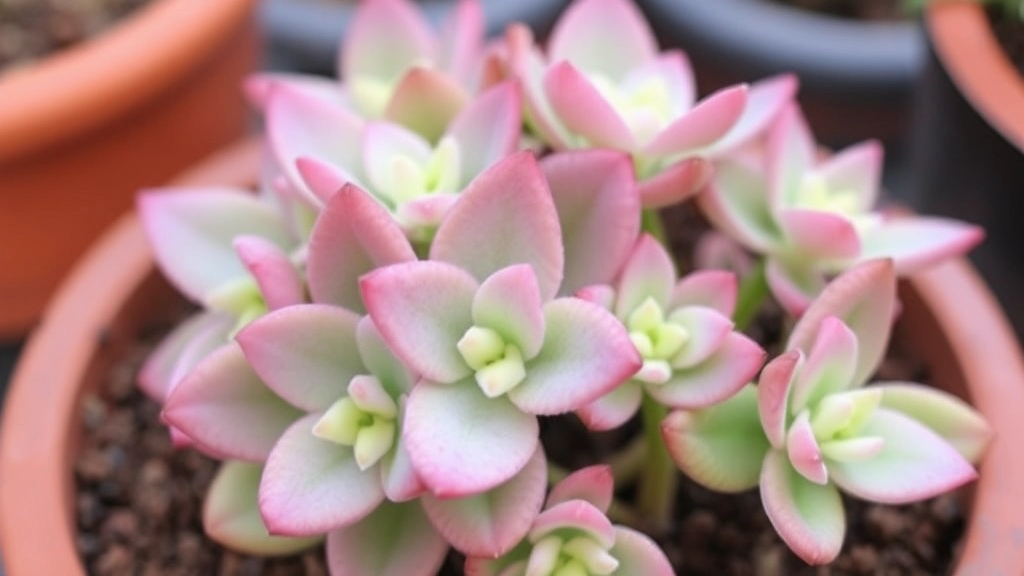
Let’s dive into the world of Kalanchoe Blossfeldiana propagation, shall we? It’s not rocket science, but it’s a game-changer if you want to multiply these beauties without breaking the bank.
Here’s the deal: Kalanchoe Blossfeldiana is a champ when it comes to propagation. It’s like nature’s way of saying, “Hey, want more of these? No problem!”
Leaf Cuttings: The Easy Peasy Method
- Snip a healthy leaf
- Let it dry for a day (callusing, they call it)
- Stick it in some well-draining soil
- Water lightly and wait
Boom! In a few weeks, you’ll see tiny plantlets popping up. It’s like magic, but it’s just plant biology doing its thing.
Stem Cuttings: The Overachiever’s Choice
- Cut a 4-inch stem below a leaf node
- Remove lower leaves
- Dip in rooting hormone (optional, but hey, why not?)
- Plant in moist, well-draining soil
- Keep warm and slightly humid
Pro tip: I’ve found that stem cuttings often grow faster than leaf cuttings. It’s like they’re on a mission to become full-fledged plants ASAP.
Division: For the Impatient Gardener
Got a big, bushy Kalanchoe? Lucky you! Here’s what you do:
- Carefully remove the plant from its pot
- Gently separate the root ball into smaller sections
- Replant each section in its own pot
- Water and treat like a mature plant
It’s like getting multiple plants for the price of one. Who doesn’t love a good deal?
Seeds: The Long Game
Honestly, I rarely bother with seeds. It’s slow, and the results can be unpredictable. But if you’re feeling adventurous:
- Collect seeds from spent flowers
- Sow on top of moist, sterile soil
- Keep warm and moist
- Wait… and wait some more
Remember, patience is a virtue, especially when it comes to seed propagation.
Common Propagation Pitfalls
Look, we’ve all been there. You’re excited, you’ve got your cuttings ready, and then… nothing happens. Here’s what might be going wrong:
- Overwatering: These succulents hate wet feet. Ease up on the H2O.
- Poor light: They need bright, indirect light to thrive.
- Wrong temperature: Too cold, and they’ll sulk. Aim for warm and cozy.
The Bottom Line
Propagating Kalanchoe Blossfeldiana is a bit like cooking. Follow the recipe, add a dash of patience, and before you know it, you’ll have a whole garden full of these colorful succulents. And the best part? You can share the love by gifting your propagated plants to friends. Who doesn’t love a living, growing gift?
Remember, every propagation attempt is a learning experience. So don’t sweat it if your first try doesn’t work out. Just dust off your hands and try again. Before long, you’ll be a Kalanchoe propagation pro, spreading these beauties far and wide.
Pests and Diseases Affecting Kalanchoe Blossfeldiana Leaves
Ever looked at your Kalanchoe and thought, “What’s eating you?”
Well, you’re not alone. These succulents can face some pesky problems.
Let’s dive into the world of Kalanchoe troublemakers.
Pests: The Uninvited Guests
- Mealybugs: These little cotton-like critters love to party on your plant.
- Spider mites: Tiny but mighty, they can cause big damage.
- Aphids: Green, sticky, and always hungry for your Kalanchoe.
Spotting the Trouble:
Look for:
- Yellowing leaves
- Sticky residue
- Tiny webs
- Distorted growth
Diseases: The Silent Killers
- Powdery mildew: Looks like someone dusted your plant with flour.
- Root rot: The underground enemy that can topple your Kalanchoe.
- Leaf spot: Brown or black spots that spread like gossip.
Prevention is Better Than Cure
- Keep it clean: Regular cleaning is like a spa day for your plant.
- Air it out: Good circulation is key. Don’t let your Kalanchoe feel stuffy.
- Water wisely: Overwatering is like inviting trouble to dinner.
- Inspect regularly: Be the detective your Kalanchoe needs.
When Trouble Strikes
- Isolate the affected plant. It’s like plant quarantine.
- Prune away the damaged parts. Sometimes you gotta cut your losses.
- Use organic treatments first. Go gentle before going nuclear.
- Last resort? Chemical treatments. But use with caution, mate.
Remember, a healthy Kalanchoe is a happy Kalanchoe.
Keep an eye out, act fast, and your Kalanchoe will thank you with those gorgeous leaves and blooms.
Pests and diseases might try to crash your Kalanchoe party, but with these tips, you’ll be the bouncer keeping them out!
Seasonal Changes in Kalanchoe Blossfeldiana Leaves
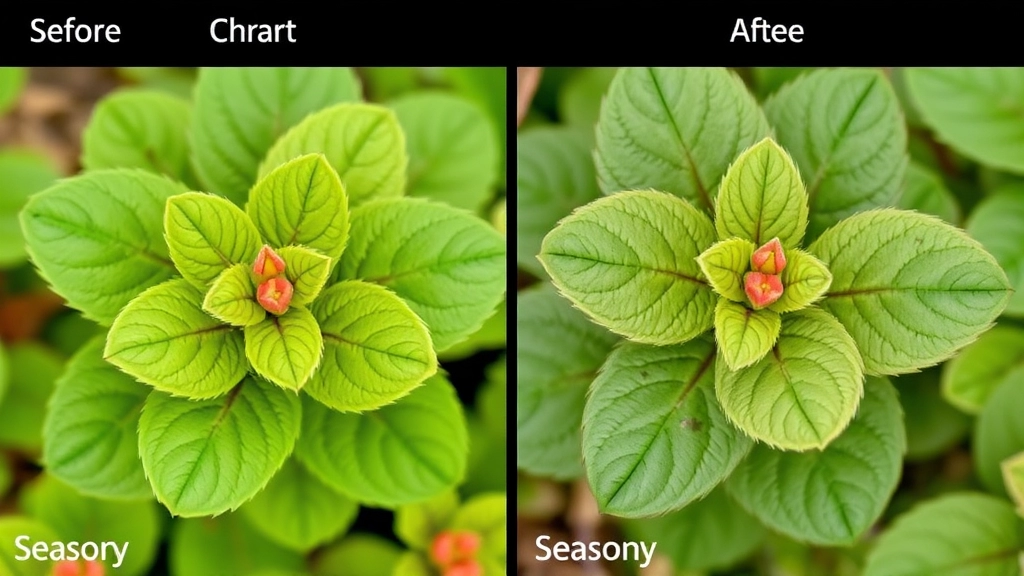
Let’s chat about how Kalanchoe blossfeldiana leaves change with the seasons. It’s like watching a plant go through its own fashion show throughout the year!
Spring: The Glow-Up
As the days get longer and warmer, your Kalanchoe’s leaves start to perk up. They’re like, “Hey, it’s party time!” You’ll notice:
- Brighter green color
- More vigorous growth
- New leaves popping up faster
Summer: The Sunbather
In summer, Kalanchoe leaves are living their best life. But watch out, they can get a bit too excited:
- Leaves might get slightly paler (if they’re getting too much sun)
- Growth rate slows down a bit (it’s too hot to work hard, right?)
- Might need more water to keep those leaves plump
Autumn: The Chill Phase
As days get shorter, your Kalanchoe starts to prep for winter:
- Leaves may develop a slight reddish tinge (it’s like they’re blushing)
- Growth slows down
- Older leaves might start to drop off (making room for the new crew)
Winter: The Cozy Time
Winter is when Kalanchoe leaves take a little breather:
- Growth almost stops
- Leaves might look a bit duller
- They’re more prone to cold damage (keep ’em warm!)
Here’s the thing: these changes are normal. Your Kalanchoe is just doing its thing, adapting to the seasons. But if you’re growing it indoors, these changes might be less dramatic. It’s like the plant’s living in a climate-controlled bubble.
Pro tip: Pay attention to these seasonal shifts. They’ll tell you when to adjust your care routine. More water in summer, less in winter. You get the drift.
Remember, Kalanchoe blossfeldiana leaves are your plant’s way of communicating. Learn to read them, and you’ll be the plant whisperer of your friend group in no time!
Nutrient Requirements for Healthy Leaves
Hey there, plant pals! Let’s chat about keeping those Kalanchoe Blossfeldiana leaves looking lush and lovely.
First things first: these beauties aren’t too fussy, but they do need some TLC in the nutrient department.
Here’s the lowdown on what your Kalanchoe’s craving:
- Nitrogen: The MVP for leafy growth
- Phosphorus: Gives your plant that energy boost
- Potassium: Helps with overall health and disease resistance
But wait, there’s more! Let’s break it down further:
Micronutrients matter too:
- Iron: Keeps those leaves green and perky
- Magnesium: Crucial for photosynthesis (fancy word for making food from sunlight)
- Calcium: Strengthens cell walls
Now, you might be wondering, “How do I feed my plant buddy?”
Easy peasy! Grab a balanced, water-soluble fertiliser.
Look for something with an NPK ratio of 10-10-10 or 20-20-20.
Pro tip: Feed your Kalanchoe every 2-4 weeks during the growing season.
But here’s the kicker: ease up on the feeding during winter. Your plant’s taking a little snooze.
Overfeeding? Big no-no. It can lead to:
- Leaf burn
- Stunted growth
- Root damage
Remember, less is more when it comes to fertilising your Kalanchoe Blossfeldiana.
Keep an eye out for these signs of nutrient deficiency:
- Yellowing leaves (could be lack of nitrogen or iron)
- Purple-tinged leaves (might need more phosphorus)
- Brown leaf edges (possibly potassium deficiency)
Bottom line: Healthy leaves need the right nutrients. Give your Kalanchoe what it needs, and it’ll reward you with stunning foliage.
So, ready to give your plant the nutrient boost it deserves? Your Kalanchoe Blossfeldiana will thank you with vibrant, healthy leaves!
Pruning and Maintenance Tips for Kalanchoe Blossfeldiana
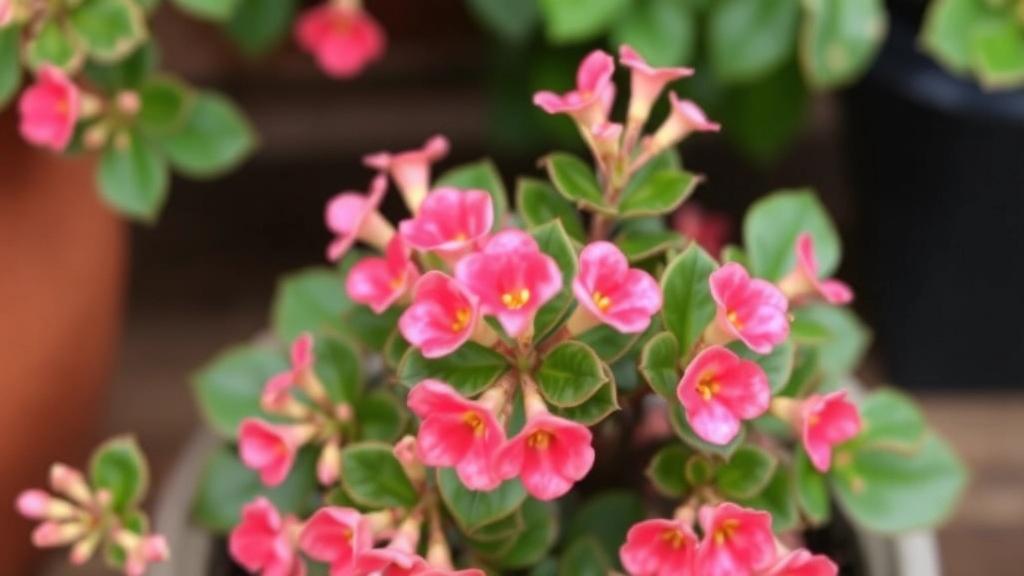
Let’s chat about keeping your Kalanchoe Blossfeldiana looking sharp. I’ve learned a thing or two about pruning these beauties, and I’m gonna spill the tea on how to keep ’em thriving.
Why Prune Your Kalanchoe?
Look, here’s the deal:
- Pruning boosts growth
- Keeps your plant compact
- Encourages more flowers
- Removes dead or diseased bits
When to Get Snippy
Timing’s everything, folks. Here’s when I grab my scissors:
- After flowering
- When it’s getting leggy
- Spring or early summer (prime growing time)
How to Prune Like a Pro
- Grab clean, sharp scissors (no blunt tools, please!)
- Cut just above a leaf node
- Remove dead or yellowing leaves
- Trim off spent flower stalks
- Shape as you go, keeping it balanced
Maintenance Hacks
- Pinch off growing tips to encourage bushiness
- Rotate the pot regularly for even growth
- Wipe leaves with a damp cloth to remove dust
Common Pruning Mistakes to Dodge
- Over-pruning (don’t go crazy, folks)
- Using dirty tools (hello, plant diseases!)
- Pruning at the wrong time (stick to post-flowering)
Remember, pruning isn’t rocket science. Start small, and you’ll get the hang of it. Your Kalanchoe will thank you with lush growth and a tidy appearance.
Quick Tip: Save those cuttings! They’re perfect for propagation. (More on that in section IV, if you’re curious.)
Maintenance Beyond Pruning
It’s not all about the snip-snip. Here’s what else your Kalanchoe needs:
- Regular dusting (leaves need to breathe, ya know?)
- Check for pests (those little buggers can sneak up on you)
- Remove dead flowers (keeps things tidy and encourages more blooms)
By sticking to these pruning and maintenance tips, your Kalanchoe Blossfeldiana will be the envy of all your plant-loving pals. Trust me, a little TLC goes a long way with these beauties.
Signs of Overwatering and Underwatering
Hey there, plant pals! Let’s chat about Kalanchoe Blossfeldiana and how to spot if you’re giving it too much or too little water.
Overwatering: The Silent Killer
Ever seen your Kalanchoe looking a bit… meh? Here’s what to watch for:
- Yellowing leaves that feel soft and mushy
- Droopy stems that can’t hold themselves up
- A funky smell coming from the soil
- Mold or algae growing on top of the soil
If you spot these, ease up on the watering can!
Underwatering: The Thirst is Real
On the flip side, here’s how your Kalanchoe might be screaming for a drink:
- Crispy, brown leaf edges
- Leaves that feel thin and papery
- Slow growth or no new leaves
- Soil that’s bone dry and pulling away from the pot sides
Time to give your plant a good soak if you see these signs!
Finding the Sweet Spot
It’s all about balance, right? Here’s a quick tip:
Stick your finger about an inch into the soil. If it’s dry, time to water. If it’s still damp, hold off.
Remember, Kalanchoe Blossfeldiana likes to dry out a bit between waterings. It’s better to underwater than overwater these beauties.
By keeping an eye out for these signs, you’ll be on your way to having a happy, healthy Kalanchoe in no time!
Enhancing Leaf Color and Texture
Let’s talk about jazzing up those Kalanchoe Blossfeldiana leaves, shall we? I’ve been obsessed with these beauties for years, and I’ve picked up a few tricks to make their leaves pop.
First things first: light is your best mate. These succulents love basking in the sun, but they’re not beach bums. Too much direct sunlight, and you’ll end up with scorched leaves. Aim for bright, indirect light to keep those leaves looking lush and vibrant.
Now, let’s chat about feeding your Kalanchoe:
- Balanced fertilizer: Go for a 20-20-20 mix during the growing season.
- Frequency: Once a month should do the trick.
- Dilution: Always dilute to half-strength. These guys aren’t big eaters.
But here’s the kicker – don’t overdo it. Too much fertilizer can lead to leggy growth and dull leaves. It’s like overfeeding a kid with sweets – not a good look.
Temperature and humidity play a big role too. Kalanchoes are pretty chill (pun intended) when it comes to average room temps, but they’re not fans of cold drafts or sudden temperature drops. Keep them cozy, and their leaves will thank you.
Here’s a pro tip: give your Kalanchoe a summer holiday outdoors. The natural light and fresh air can work wonders for leaf color and texture. Just make sure to ease them into it – sunburn is real for plants too!
Water quality matters more than you’d think. If you’re using tap water, let it sit out overnight to let the chlorine evaporate. Your Kalanchoe’s leaves will look smoother and healthier for it.
Lastly, don’t forget about good old-fashioned grooming. Regularly dusting the leaves not only keeps them looking sharp but also helps them breathe better. It’s like a spa day for your plant!
Remember, enhancing leaf color and texture isn’t about quick fixes. It’s about consistent, thoughtful care. Treat your Kalanchoe Blossfeldiana right, and you’ll be rewarded with leaves that are the envy of every plant parent out there.
FAQs about Kalanchoe Blossfeldiana Leaves
Q: How often should I water my Kalanchoe Blossfeldiana?
A: Water your Kalanchoe when the top inch of soil feels dry. This typically means watering every 2-3 weeks, but it can vary based on environmental conditions. Remember, it’s better to underwater than overwater these succulents.
Q: Why are my Kalanchoe’s leaves turning yellow?
A: Yellowing leaves can be a sign of overwatering, poor drainage, or nutrient deficiency. Check your watering habits first, ensure the pot has drainage holes, and consider fertilizing if you haven’t done so recently.
Q: Can I propagate Kalanchoe Blossfeldiana from leaves?
A: Yes, you can! Take a healthy leaf, let it callus for a day or two, then place it on well-draining soil. Keep the soil lightly moist, and you should see roots and tiny plantlets in a few weeks.
Q: How do I encourage more vibrant leaf color in my Kalanchoe?
A: Provide bright, indirect light and use a balanced fertilizer during the growing season. Some varieties may develop reddish tints when exposed to cooler temperatures or slight stress.
Q: Are Kalanchoe Blossfeldiana leaves toxic to pets?
A: Yes, Kalanchoe leaves are toxic to cats, dogs, and other pets if ingested. Keep your plants out of reach of curious pets to avoid any potential issues.
Q: How can I prevent pests on my Kalanchoe’s leaves?
A: Regularly inspect your plant, keep the leaves clean and dust-free, and ensure good air circulation. If you spot pests early, you can often remove them with a cotton swab dipped in rubbing alcohol.
Q: Why are my Kalanchoe’s leaves curling?
A: Leaf curling can be caused by underwatering, pest infestation, or temperature extremes. Check your plant’s environment and adjust care accordingly.
Q: How often should I prune my Kalanchoe Blossfeldiana?
A: Prune your Kalanchoe after it finishes flowering, typically in late spring or early summer. This encourages bushier growth and more flowers in the next blooming cycle.
References
-
Missouri Botanical Garden – Kalanchoe blossfeldiana Plant Finder: Kalanchoe blossfeldiana

